八年级下册英语unit6教案
- 格式:doc
- 大小:336.00 KB
- 文档页数:19
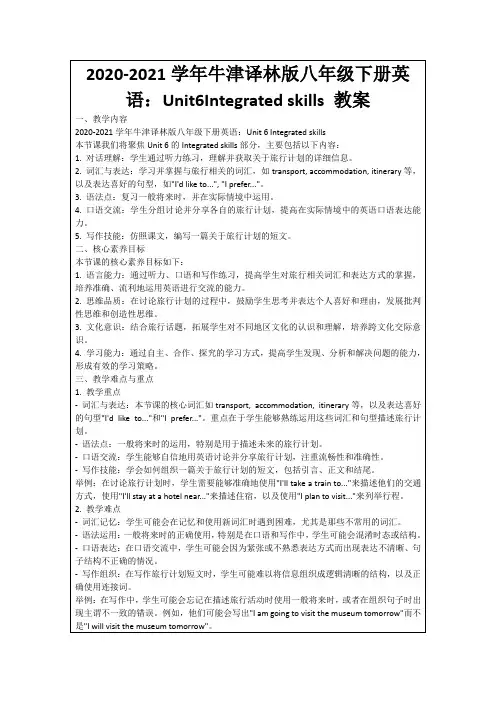
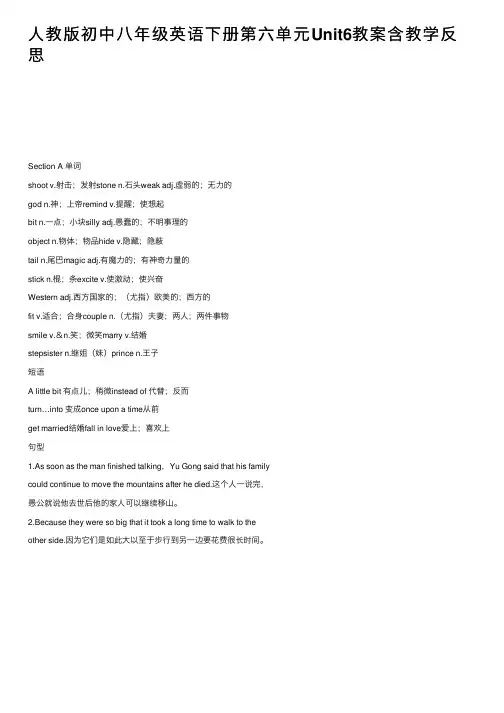
⼈教版初中⼋年级英语下册第六单元Unit6教案含教学反思Section A 单词shoot v.射击;发射stone n.⽯头weak adj.虚弱的;⽆⼒的god n.神;上帝remind v.提醒;使想起bit n.⼀点;⼩块silly adj.愚蠢的;不明事理的object n.物体;物品hide v.隐藏;隐蔽tail n.尾巴magic adj.有魔⼒的;有神奇⼒量的stick n.棍;条excite v.使激动;使兴奋Western adj.西⽅国家的;(尤指)欧美的;西⽅的fit v.适合;合⾝couple n.(尤指)夫妻;两⼈;两件事物smile v.&n.笑;微笑marry v.结婚stepsister n.继姐(妹)prince n.王⼦短语A little bit 有点⼉;稍微instead of 代替;反⽽turn…into 变成once upon a time从前get married结婚fall in love爱上;喜欢上句型1.As soon as the man finished talking,Yu Gong said that his familycould continue to move the mountains after he died.这个⼈⼀说完,愚公就说他去世后他的家⼈可以继续移⼭。
2.Because they were so big that it took a long time to walk to theother side.因为它们是如此⼤以⾄于步⾏到另⼀边要花费很长时间。
句型1.Tonight,when the moon is shining bright,we’ll be able to see th e stones.今晚,当⽉光明亮地照耀着⼤地时,我们就能看见这些⽯头了。
2.As soon as you wake up,you must go to the forest with your father.你们⼀醒就必须和你们的⽗亲去森林。

- 1 -- 3 -- 5 -Knowledge aims:1. Words: wife, husband, ground, voice, brave, bright, stepmother, scene2. Phrases: get lost, wake up, make a plan, in the moonlight, shining bright, change the plan, something bad,not… until, be make of, brave enough, plan to do sth.Ability aims: Be able to write a reasonable story ending according to the development of the story.Emotional aims: Reading makes a full man.※教学重难点※Teaching important points: To understand the performance of the western fairy tales, try to use the form of performance or generalization to carry out the language output.Teaching difficult points: The interpretation of the play and the proper use of words.※教学准备※Teaching aids: CAI※教学过程设计※Step 1 Talking1. (2a) Show some fairy tales. Tell Ss a fairy tale is an old, tradi tional story. Do you know what these fairy stories are about? Now discuss them with your partner.2. Ask some Ss say what they know about the fairy stories.e.g. Sleeping Beauty:A lovely princess had to sleep for 100 hundred years because of an evil magic. One hundred years later, ayoung prince came and saved the princes. They got married and had a happy life.Step 2 Reading1. Work on 2b. Tell Ss the following is a fairy tale. It’s name’s Hansel and Gretel.2. Before ReadingAsk Ss to read through the passage and decide what kind of text it is. Is it a letter, a play a short story or so mething else? (Ss may find out that it’s a play.)3. Fast Reading:1) T: Now let’s work on 2b. First, let’s read the questions and make sure we know the meanings of all thequestions. Then read the passage quickly and find the answers to the questions.2) Ss read the letter quickly and try to find the answers to the two questions.3) Check the answers with the class.4. Careful Reading: Work on 2c1) T: Now let’s read the play carefully and try to match each description below with the correct scene.2) Ss read the play care fully and try to match each description.3) Check the answers with the class.5. Post reading: Work on 2d1) Now let’s work on 2d. First read the questions below. Then try to read the play again and find the answersto the questions.2) Ss read the play again and try to find the answers to the questions.3) Let some Ss read their answers and correct their mistakes.4) Ss check their answers with their partners.Step 3 Language points1. One year, the weather was so dry that no food would grow.eg.: That bird’s song is so beautiful that we would follow it.2. We thought you were never coming back.We thought… 表示人们过去的某种想法,判断等,可以译作“我们原想……; 我们本以为……”。
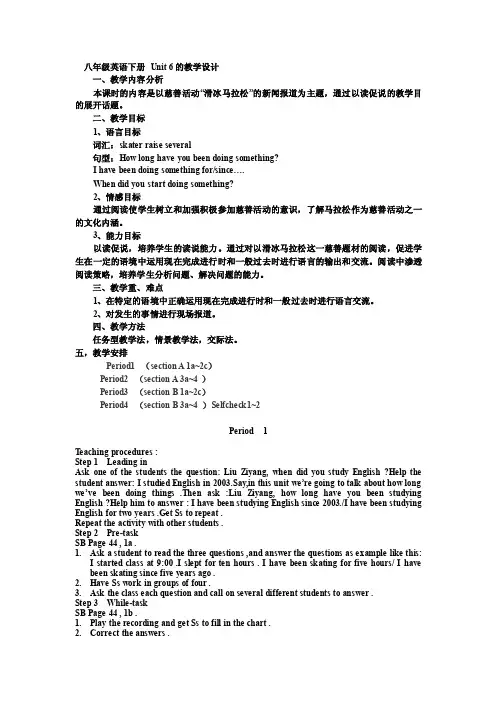
八年级英语下册Unit 6的教学设计一、教学内容分析本课时的内容是以慈善活动“滑冰马拉松”的新闻报道为主题,通过以读促说的教学目的展开话题。
二、教学目标1、语言目标词汇:skater raise several句型:How long have you been doing something?I have been doing something for/since….When did you start doing something?2、情感目标通过阅读使学生树立和加强积极参加慈善活动的意识,了解马拉松作为慈善活动之一的文化内涵。
3、能力目标以读促说,培养学生的读说能力。
通过对以滑冰马拉松这一慈善题材的阅读,促进学生在一定的语境中运用现在完成进行时和一般过去时进行语言的输出和交流。
阅读中渗透阅读策略,培养学生分析问题、解决问题的能力。
三、教学重、难点1、在特定的语境中正确运用现在完成进行时和一般过去时进行语言交流。
2、对发生的事情进行现场报道。
四、教学方法任务型教学法,情景教学法,交际法。
五,教学安排Period1 (section A 1a~2c)Period2 (section A 3a~4 )Period3 (section B 1a~2c)Period4 (section B 3a~4 )Selfcheck1~2Period 1T eaching procedures :Step 1 Leading inAsk one of the students the question: Liu Ziyang, when did you study English ?Help the student answer: I studied English in 2003.Say,in this unit we’re going to talk about how long we’ve been doing things .Then ask :Liu Ziyang, how long have you been studying English ?Help him to answer : I have been studying English since 2003./I have been studying English for two years .Get Ss to repeat .Repeat the activity with other students .Step 2 Pre-taskSB Page 44 , 1a .1.Ask a student to read the three questions ,and answer the questions as example like this:I started class at 9:00 .I slept for ten hours . I have been skating for five hours/ I havebeen skating since five years ago .2.Have Ss work in groups of four .3.Ask the class each question and call on several different students to answer .Step 3 While-taskSB Page 44 , 1b .1.Play the recording and get Ss to fill in the chart .2.Correct the answers .SB Page 44 , 1c .In pairs ,get the students to ask and answer .Then ask some pairs to say their conversations to the class.SB Page 45 , 2a & 2b .1.Read the instructions and have Ss know what to do .2.Play the recording .Ss write down their answers .3.Correct the answers .Step 4 Post-taskSB Page 45 , 2c .1.Read the example in sample dialogue in activity 2c .2.In pairs,role play the interview between Alison and the reporter .3.Ask two pairs to say their conversations to the class .Step 5 Grammar FocusSB Page 45 , grammar focus .1.Review the grammar box .2.Explain that in these sentences “since” comes before a date and “for” before a period oftime .3.Ask What is the difference between “How long did you skate ?”and “How long have youbeen skating?” .Explain that “did” question means that the person has stopped doing the action .The “have you been” question shows that the person is continuing to do the action at the present moment .Step 6 HomeworkReview the present perfect progressive .四、本课小结从本节课的课堂教学活动内容来看,听、说、读、写活动贯穿于新目标英语教学的各个环节,可见,对学生各种英语学习基本技能的训练与培养是目前英语课堂教学的重中之重。

初中英语八年级下册Unit 6 SectionA (1a—1c)教学设计1.教学目标1.知识与技能:让学生学会用英语讲述一个故事。
2.过程与方法:通过复述故事,让学生学会掌握一个故事的细节和人物,并能利用目标语言讲述一个传说或故事。
3.情感、态度与价值观:教育学生在生活中不怕困难,培养他们不言放弃的精神。
2.学情分析1. 八年级的学生积累了一定的词汇量,也学过过去时态,对于本课内容的理解并不难。
但在叙述故事过程中有大量的复杂句,对于长句子的理解、复述和表达成为本课难点。
所以对于部分使用率高的复杂句,利用课件中大量的图片进行练习,让学生掌握扎实。
2. 本班学生两极分化严重,后面的学生基础非常薄弱,且对英语学习兴趣不高,他们在本课学习上会有很大的困难。
所以本课我使用了大量的图片、视频提升学生兴趣,帮助他们首先理解授课内容,反复练习达到基本上口的目标,然后充分发挥思维导图的优势帮助他们学习讲述故事。
小步子,快节奏,低台阶,层次强的授课模式来激发学生的兴趣,增强学习英语的自信,训练能力的提升。
3.重点难点教学重点:学习讲述故事中的人物和相关细节。
教学难点:学习本课时的目标语言,能用自己的语言讲述一个故事。
教学过程第一学时教学活动活动1【导入】创设情景Step1 Warmig up(1)Free talk&enjoy a story named a wolf is coming .1. Do you like stories?2. What kind of stories do you like? (老师可以鼓励学生给出尽可能多的答案)教学设计说明:通过自由讨论故事,欣赏动画故事,承上启下,引出本单元话题。
活动2【讲授】呈现新课Step 2. Presentation(呈现新知识)1.Present the new words :stoone shoot2.Present the name of the story with the picture(教师用同样的方法教授其它故事的名字:1)Journey to the West2)Yu Gong Moves a Mountain3)Hou Yi Shoots the Sun4)Nu Wa Repairs the Sky教学设计说明:教师利用对图片的讨论和问答教授四个故事的名字,形象生动,且能了解故事概要。

Unit 6 An old man tried to move the mountains.教师授课时间课时5-1课题Unit 6 Section A (1a-2d)课型新授教学目标1.掌握重点单词和短语:shoot,begin,instead ,remind,silly, stone,Journey to the West,Yu Gong Moves a Mountain,Hou Yi shoots the Suns,Nu Wa Repairs the Sky,once upon a time,instead of,work on,a little bit。
2.掌握重点句式:An old man tried to move the mountains.How does the story begin?Where would they put al l the earth and stone from the mountains?The story is trying to show us that anything is possible if you work hard.3.通过听、说、读、写等任务型活动,熟练应用词汇和句型。
4.可以用英语讲述寓言小故事。
重点1.重点短语和句型。
2.unless,so...that,as soon as...等的用法。
难点学会表达故事中的人物或情节,并发表一些简单的看法或观点。
教学环节问题分层设置旁注教学内容复习旧课(新课预习、作业的检查)问候学生关于古代寓言故事知道多少。
新课导入(Play a song Yu Gong Moves a Mountain)通过听歌曲,师生问答导入新课。
讲授新课(教学内容) 问题分层设置旁注Step 1.Presentation1. 引导学生们学习生词。
让学生们看大屏幕来学习本课时的生词: once upon a time, shoot, stone2. Try to remember the new words.Step 2 .Writing(1a)1. Look at the pictures in 1a, then read the names of the story inthe box.2. Discuss with their partners and match the names of the storieswith the pictures.Step3 .Listening(1b)1.T: Tell Ss they will hear a great Chinese traditional story.Listen and see who know the name of the story.2. Play the recording for the Ss to listen.3. Ss who know the name of the story may hand up.4. Play the recording again. Let Ss check the facts they hear.Step 4. Pair work(1c)Ss discuss the questions with their partners.e.g. A: How does the story happen?B: There were two very tall mountains in front of their house.A: What happened next?B: A very old man tried to move the mountains.A: Where would they put all the earth and stone from themountains?B: They would pu t them into the sea.Step 5 Listening(2a、2b、2c)Work on 2a1.Look at the pictures in 2a. Discuss the things they are going todo. When you listen to the story, please number the pictures.2. Play the recording for the Ss to listen and number thepictures.3. Play the recording again to check the answers.Work on 2b:1. Let Ss read the sentences below. Expl ain some main sent encesfor the Ss. Make sure they know what to do.2. Play the recording for the Ss to circle the correct words in thebrackets.Step 6 Role-play(2d)Some main points:(1) 1. This story reminds us that you can never know what’s possible unless you try to make it happen.remind v. 提醒;使想起remind sb. of/about sth. 提醒某人想起某事e.g. The picture reminds him of his beautiful hometown.这幅画让他想起了美丽的故乡。
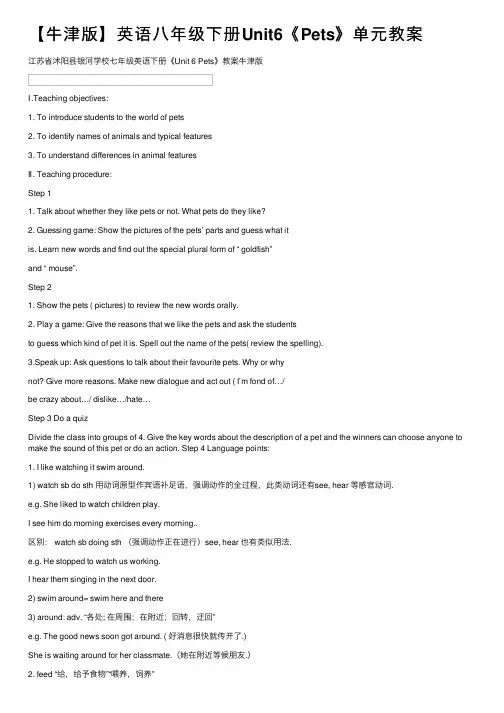
【⽜津版】英语⼋年级下册Unit6《Pets》单元教案江苏省沭阳县银河学校七年级英语下册《Unit 6 Pets》教案⽜津版Ⅰ.Teaching objectives:1. To introduce students to the world of pets2. To identify names of animals and typical features3. To understand differences in animal featuresⅡ. Teaching procedure:Step 11. Talk about whether they like pets or not. What pets do they like?2. Guessing game: Show the pictures of the pets’ parts and guess what itis. Learn new words and find out the special plural form of “ goldfish”and “ mouse”.Step 21. Show the pets ( pictures) to review the new words orally.2. Play a game: Give the reasons that we like the pets and ask the studentsto guess which kind of pet it is. Spell out the name of the pets( review the spelling).3.Speak up: Ask questions to talk about their favourite pets. Why or whynot? Give more reasons. Make new dialogue and act out ( I’m fond of…/be crazy about…/ dislike…/hate…Step 3 Do a quizDivide the class into groups of 4. Give the key words about the description of a pet and the winners can choose anyone to make the sound of this pet or do an action. Step 4 Language points:1. I like watching it swim around.1) watch sb do sth ⽤动词原型作宾语补⾜语,强调动作的全过程,此类动词还有see, hear 等感官动词.e.g. She liked to watch children play.I see him do morning exercises every morning..区别: watch sb doing sth (强调动作正在进⾏)see, hear 也有类似⽤法.e.g. He stopped to watch us working.I hear them singing in the next door.2) swim around= swim here and there3) around: adv. “各处; 在周围;在附近;回转,迂回”e.g. The good news soon got around. ( 好消息很快就传开了.)She is waiting around for her classmate.(她在附近等候朋友.)2. feed “给,给予⾷物”“喂养,饲养”1) feed on 以…为⾷,靠….为⽣;2) fe ed ….( on ) st h / feed sth to ….⽤….喂,给…吃….e.g. We often feed the cats ( on ) fish. / feed fish to the cats.Horses feed on grass.3. I want to teach it to speak.1) teach sb sth2) teach sb to do sthe.g. Her father taught her to swim when she was six years old.He taught us ( how ) to play computer games.Step 5 Comic strip:1. Get students to go through the comic strip and ask some to read and understand the sentences in the pictures.1) Eddie 对Hobo使⽤了什么句型,为什么?2) 作为主⼈Eddie 是否应使⽤please.2. Get them to find out the main idea and guess what we will learn in this unit. Step 6 GameTwo students make a group. One describes a pet’s features, look, feeding habits, home, behaviour, etc. The other one acts out. At last they can ask another one to guess the name of the pet.ReadingⅠ. Teaching Objectives1、To learn about rhyme schemes, stress and intonation of poetry2、To learn new vocabulary to talk about pets3、To read about animal behaviourⅡ. Teaching procedure:Step 1 Learn new words.Read the words in the box and complete the poem.My dog is the cleverest animal of all.He doesn’t just ______ and catch a ball.With eyes open wide,He _____ when I hide.He does wonderful_______,Builds me camps out of sticks.He’d never bark or_____,And he doesn’t like to_____.My dog is my very best friend,And I’ll look after him until the______.Listen to the poem and check the answers.Step 2 Do exercise C1 on page 96 and check the answers.Step 3 Listen to the poem and do Exercise B1 on page 95.S tep 4 Look at the goldfish’ picture and discuss.I also like goldfish very much. I know a lot of about it. What about you? Would you like to answer some questions? Does a goldfish chase another fish?Does a goldfish hide?Does a goldfish bark?Does a goldfish fight?Does a goldfish bite?Does a goldfish need a bed?Does a goldfish miaow?Does a goldfish eat much?Does a goldfish need a rabbit hutch?Step 5 listen to the poem My Goldfish and read aloud.Step 6 Read the poem My Goldfish and do exercise C2 on page 96.Step 7 Discuss: Where can you find cats sleeping?Step 8 Listen to the poem Cats and read aloud.Step 9 Read the poem Cats and do exercise C3 on page 96.Step 10 Language points.1.My dog is the cleverest of all.eg. He’s the tallest of the th ree.She’s the most careful in her class.The boy is the best player in the school team.2.With eyes open wide, he hunts when I hide.1) with + n. / pron. + 分词/adj./介短/不定词/adv.表伴随eg:I gave my seat to the woman with a baby in her arms.He sleeps with windows open.With little time to think, we have to put out the fire.2) hunt 搜寻,打猎 go hunting 不打猎hunt for sb./sth. 搜索某⼈或某物eg.: They’re hunting for sth. to eat.3) hide 躲藏,隐藏eg:Where are they hiding?Be in hiding/Go into hiding “藏起来了”,“躲起来了”He didn’t want to join us at play that afternoon, he was in hiding somewhere.3.He does wonderful tricks.trick n.[C] 诡计;骗局;谋略;花招He got into the castle by a trick.他耍了个花招混进了城堡.eg.: Don’t try any tricks (别耍花招)The boy often plays tricks on others.trick vt. 哄骗They tricked me into making a mistake.他们骗我犯错.trick v. 捉弄play “Trick or Treat” on Halloween Day (Oct. 31) 在万圣节玩⼀种“Trick or Treat”的游戏4.I’ll look after him u ntil the enduntil. “ 直到…”主句中动词为延续性动词. 也可⽤till, 但till⼀般不⽤于句⾸. not …until “ 直到…才” 主句中动词为⾮延续性动词.e.g. We’ll wait for you until you come.They didn’t get to the railway station until the train left.5.She is never trouble.trouble v. 使焦虑,⿇烦,费⼼了;trou ble n.(c) 各种各样的困难n. (u) 苦恼,困难,⿇烦;in trouble 处于危险,痛苦,忧虑环境中.e.g.I’m sorry to trouble you to take him back.When he’s in trouble, nobody wants to help him.The final exam gave me trouble for some days.Step 11 HomeworkRecite the poems.VocabularyⅠ. Teaching objectives1.To recognize an d identify a range of animal features2.To differentiate between features belonging to different animals3.To use appropriate nouns and verbs when describing the appearance andcharacteristics of different types of animalsⅡ. Teaching procedure:Step 1: Let’s know many kinds of animalsWhat are they? Dogs, lions ,two goldfish, horses, butterfly-four butterflies, tigers,cats, two deer cows, dragonfly-dragonflies 蜻蜓,shark-sharks[鱼]鲨鱼,sheep--twosheep绵⽺,panda--pandasStep 2 :Choose the best answer.()1. Would you please teach me _____ first.A.danceB. dancingC. dancesD. to dance( ) 2. I'll ▁▁ you some seafood .It's very delicious .A.takeB. bringC. getD. sent ( ) 3. You ▁▁▁▁▁▁ more careful next time .A. should beB. shouldC. must beD. should do( ) 4. Kate often sees Jim ▁▁ football in the football field.A.playsB. playingC. playD. to playStep 3: Play a gameTwo students make a group. One is saying: “I am white and lovely. I have long ears. And I live in a cage…”The other acts out(表演).PS:features(特征),looks, feeding habits, home, behaviour(⾏为)…Step 5 : Free talkA: Which is your favourite pet?B: Fish/Cats/….A: Why do you like your pet?B: Because I like watching it swim around/…Step 6: Talk about animals1. Birds have beaks, which they use to eat and drink .2. Birds have feathers. They look so beautiful in the sun.3. Fish have fins to swim in the water in all directions.4. Fish have fins to swim in the water in all directions.5. Fish have scales while birds have feathers.6. There are whiskers around the mouths of cats, dogs, fish, etc.7. Animals walk with paws, catch food with paws. cats play balls with paws.8. Birds,chickens,ducks have wings. Birds use wings to fly high in the sky.9. We feed pandas in a cage. They o ften knock on the cage door.Step 7: Fill in the missing words.1. A parrot uses its b____ to eat and drink.2. Goldfish swim around with their f___ and t___ .3. A cat does not have w______ , so it can’t fly.4.But it has p_____, so it can catch a mouse.5. A parrot’s f________ look beautiful in the sun.6.Do not pull a cat’s w________. It does not like that .Step 8: Do Part B1. I have a black cat. She has four white paws and a black- and- white tail.She likes to ________ balls. When she gets tired, she _______ in the armchair.She _______ when she wants some food. She always _________ herself in the cupboard.2. My parrot is a very special friend. His blue-and-green feathers look sobeautiful in the sun. He is very clever and he learns to _____ the words I say.He ________ “Hello” when I go back home. When he is hungry, he always _________ on the cage door .When he is full, he __________ happily.Step 9: Make profiles of animals1. Hello. My name is Polly. I am a beautiful ____.I have colorful____________on my body. They keep me warm. I can fly because I have two _______.I knock on my cage door with my _______when I am hungry. My master loves me very much.He thinks I am an unusual bird because I can say “Hello” to him!2.Do you know me? I am a lovely ___________.I have two big eyes and a smallmouth. I have “clothes ”o ver my body. They are my _________.With the help of the _____ and the _____,I can swim very well. Most people think I am a wonderful pet because I do not make any trouble .I don’t eat a lot and just bubble .Step 10: ProverbsGo to the sea, if you would fish well.不⼊虎⽳,焉得虎⼦.A cat has nine lives.猫有九条命,吉⼈天相.If water is noisy, there are no fish in it. 咆哮的⽔中⽆鱼.(夸夸其谈者⽆真才实学)GrammarⅠ.Teaching Objectives:1. To learn the pronunciation and the correct forms of ‘should(not)’and ‘must(not)’2. To unders tand the meaning of ‘should’, and ‘must’3. To use the modals ‘should’ and ‘must’ to talk about duties an d responsibilitiesⅡ. Teaching procedure:Step 1: RevisionGuessing game: One of the students come to the front. He or she will describe an animal’s features, looks, feeding habits, home, behavior and so on. The others have to guess the name of the animal.Step 2: Presentation1. How to look after a pet : feed your pet, look after your pet, play with your petfor some time, feed your cat some fish, brush your cat every day, give your goldfish clean water, don’t bring your pet to school , don’t feed your pet too much food, don’t feed your pet at the table2. Make sentences with “should (not), must (not)” to give advice. For example: You should/ought t o play with your pet for some time every day. You mustn’t feed your pet too much food.Step3: PracticeRearrange the words to make sentences1.clean the cage/should /once a week/You2.You/once a day/should/take her out to the park.3.You/your dog /must/out more often/take4.a good cat brush/You/get/should5.must/from the pet shop/You/special bird food/buy6.get a dog/you /If your flat is very small/should not7.pick up a goldfish/must not/You/with your hand8.every day/ought to/You/walk your cat/notStep4: PresentationWe use“should(not), must(not)” to give advice. When we tell people thatit is very important to do something or not to do something, we use“must,must not/mustn’t”Step5: PracticeMake notes with “should (not), must (not) ”Doschange the water every daymake sure the water is not too cold or too hotput some stones at the bottom of the tankDon’tsgive it too much foodput your goldfish in the suntake it out of the waterStep6: UsingDiscuss two questions.1. My sister’s dog barks a lot. She cannot study because it makes too much noise. What can she do?2. My brother bought a parrot yesterday, but he doesn’t know how to look after it. Step 7: Extension activity1. Watch a video: Hua Cheng is one of the students. Please watch Hua Cheng’s D ay. After watching the teacher asks “Is hea good student? What should a good student do?” Ask students to make up their ideas in group four. Write down their ideas on the paper. For example: A good student should(not), ought (not) to, must (not) .Then check it up.2.Write a short passage according to our discussion.Step 8 HomeworkWrite a short passage according to our discussion.Integrated skillsⅠ. Teaching Objectives1.To identify specific characteristics in a description of goldfish .2.To listen for detail and extract specific information .3.To use knowledge presented in written text to infer general meaning and context . Ⅱ. Teaching procedure:Step 1 The fantail goldfishHow to look after a goldfish?1. Can you put a goldfish in the sun?2. Is a goldfish heavy?3. Does a goldfish weigh several kilograms?4. Is the body of a goldfish like a banana or an egg?5. Does it need clean water?6. Can you take it out of the water?7. Does it need special fish food?8. Is it very difficult to look after a goldfish? 9. Is a go ldfish very expensive?Step 2 Fantail goldfishLook! It has Long an d beautiful fins.Its tail looks like a fan.Step 3 Listen to a talk on the fantail goldfish and write a T or F (P102 A1) The right way to look after a fantail goldfishGive it too much fo od You should --- You shouldn’t ---You must --- You mustn’t ---Step 4 Ask students to write down 6 right sentences in their booksTalk about the differences between should, shouldn’t, must and mustn’tMake more sentences with should, shouldn’t, must and mustn’tStep 5 To talk about how to look after the fantail goldfish1. Have a look at the dialogue between Amy and Peter, try to finish the dialogue with the help of the words in the box and the information in A1 and A2.2. Listen to the tape and check the answers.3. Practise reading the dialogue in pairs and have “role-plays”Step 6 Talk about your likes or dislikes like this.A: What is your favourite pet?B: I really like _________.A: Why?B: Because__________________________.A: what about_________________?B:I like ________ too, but I don’t like_________.A: Why not?B:_______________________________.Step 7 Language points1.Fantail goldfish are easy to look after.1)Fantail goldfish 是look after 宾语, look after 不再接宾语.2)此句也可以⽤:It’s easy to look after fantail goldfish.类似的句型:This problem is hard to work out.= It’s hard to work out this problem.2.Make sure the water is not too hot or too cold.1)整个分句是个宾语从句,省略了 that.2)Not too hot or too cold= neither too hot nor too coldeg. This book is not yours or mine.= This book is neither yours nor mine.3)make sure that / of 确信be sure that … / be sure of/about …“相信…” “对…有把握”be sure to do 务必要,⼀定会eg. I’m sure that he will buy a present for me.He’s sure of beating me.Be sure to write to me. 务必要给我写信阿3. At the bottom of 在…底部”= at the top of 在…顶部eg. He can see sth at the bottom of the river.My office is at the top of the building.Step 8 Homework:1 .⽤祈使句、情态动词should和must写6条照顾宠物的说明2.翻译句⼦1)你为什么养猫啊?因为它很好照看的.2)⼀只⾦鱼有多重?⼤概不超过半公⽄吧.3)宝宝在睡觉,不要发出任何声响.4)在阳光下看书对眼睛不好.5)这⾥的春天很好,不太冷也不太热.Main taskⅠ. Teaching Objectives1. To present factual information and opinions in writing.2.To describe characteristics and personalities of pets.3.To describe pets’ lifestyles, including feeding habits, homes, likes anddislikes.4.To generate personal idea, plan and organize text to express one’s ownopinions.5.To present an article about a favourite pet.Ⅱ. Teaching procedure:Step 1 Play a guessing gameI have long ears. I eat lots of vegetables.I have fur. I sleep a lot. My favorite food is fish.I love to play with balls and sticks. Sometimes, I bark at people. Step 2 Listen and answer1、Who does Poppy belong to?2、How old is she?rabbit3、What color are her eyes?4、How much does she weigh?5、What will she do if she is hungry?6、What’s her personality?Step 3 Write “T” or “F”1.Her favorite food is milk. ( )2.She likes sleeping in the armchair.( )3.She often plays with pieces of string. ( )4.She hates the rain. ( )5.Amy feeds the cat twice a day. ( )6. Poppy is sometimes lazy.( )7.She often worries because we don’t take good care of her. ( ) Step 4 Read it by yourselves, then fill in the table.Here is the table.Step 5 Write our own article .1. Introduction (介绍) Say what kind animal it is.2.Main body (正⽂、主体)A. Describe(描述) its appearance(外貌).B. Describe its qualities( 品质、特性).C. Write about its food, its home, its likes and dislikes .D .write about how you look after it.3.Conclusion (结论)Say why your favorite pet is specialStep 6 Sample writing(例作)My pet’s name is Dudu. He’s a parrot . He is two years old now. Dudu has long red, blue and yellow feathers and small black eyes. He has a large beak and a very long tail. He is very clever. When I say ‘Hello’ to Pedro, he always tries to say ‘Hello’back. Dudu likes to eat seed(种⼦) and nuts(坚果). His beak is very strong, so he can open nutshells(果壳) by himself. I feed him and change his water every day. Usually, I clean his cage twice a week. Dudu is my special friend butsometimeshe is noisy. when he is outside his cage, he sings happily! Step 7 ExamplesStep 8 Write your own article. These useful expressions may help youI love/like my…very much.Its name is…It is always very friendly.My pet is…My…looks like…It usually sits/lies on the bed/ floor.It likes/does not like…It lives in a cage/basket/box.It needs/must have…We should/should not…We must/must notStep 9 Show your article.。
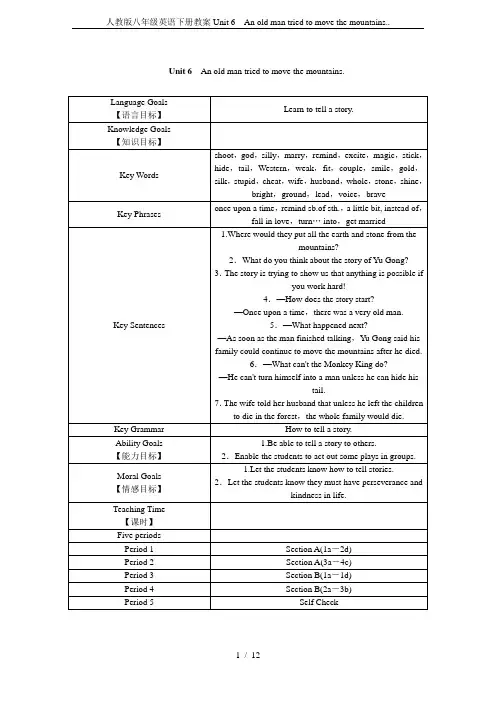
Unit 6An old man tried to move the mountains.本单元教材以“谈论故事情节”为中心话题,围绕着学生非常熟悉的故事进行,学习和运用几个常见的句型:Where would they put all the earth and stone from the mountains?/What do you think about the story of Yu Gong?/The story is trying to show us that anything is possible if you work hard!/—How does the story start?—Once upon a time,there was a very old man./—What happened next?—As soon as the man finished talking,Y u Gong said his family could continue to move the mountains after he died.等。
在学习过程中,学生在交流中,能促进师生之间的感情。
Section A 主要学习once upon a time,remind sb.of sth.,a little bit, instead of,turn… into,get married等几个常见的短语及怎样讲故事。
通过短文介绍了《西游记》在英国放映的事情,增加了学生的阅读量。
Section B 安排了听、说、读、写的任务,通过《皇帝的新装》来训练学生的听力,通过《韩赛尔与格雷特》训练学生的阅读能力。
教师在教学中应合理利用课本上的知识进行教学。
第一课时Section A(1a-2d)Teaching Key Points【教学重点】The vocabulary:shoot,stone,weak,god,silly,remind sb.of sth.,a little bit, instead ofTarget language:1.Where would they put all the earth and stone from the mountains?2.What do you think about the story of Yu Gong?3.The story is trying to show us that anything is possible if you work hard!Teaching Difficult Points【教学难点】Use the target language above to tell a story.Teaching Aids【教学工具】an English book,a tape recorder and CAITeaching Steps【教学过程】★Step 1Preview and perception【预习感知】Ask the students to read the vocabulary and target language.Ⅰ.根据句意及汉语或首字母提示写单词。
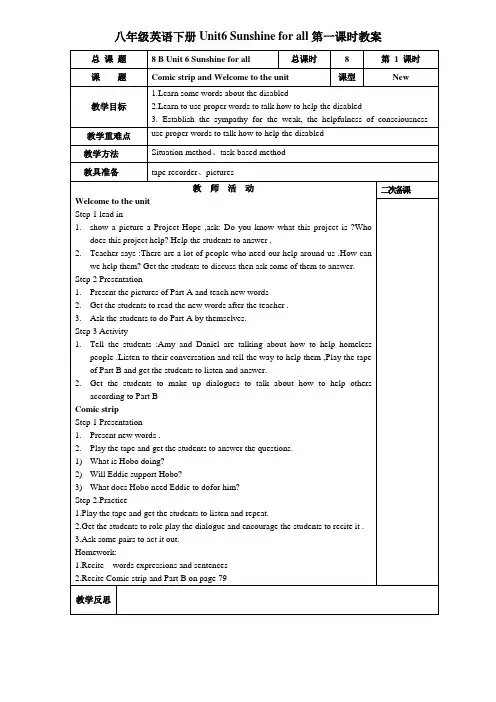
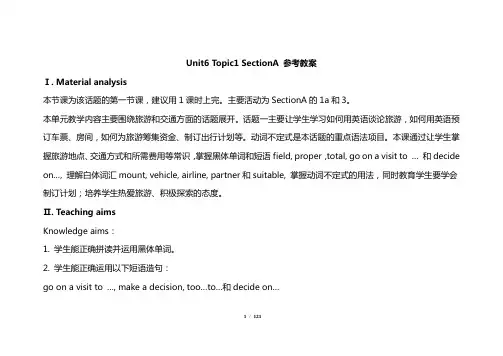
Unit6 Topic1 SectionA 参考教案Ⅰ. Material analysis本节课为该话题的第一节课,建议用1课时上完。
主要活动为SectionA的1a和3。
本单元教学内容主要围绕旅游和交通方面的话题展开。
话题一主要让学生学习如何用英语谈论旅游,如何用英语预订车票、房间,如何为旅游筹集资金、制订出行计划等。
动词不定式是本话题的重点语法项目。
本课通过让学生掌握旅游地点、交通方式和所需费用等常识,掌握黑体单词和短语field, proper,total, go on a visit to …和decide on…, 理解白体词汇mount, vehicle, airline, partner和suitable, 掌握动词不定式的用法,同时教育学生要学会制订计划;培养学生热爱旅游、积极探索的态度。
Ⅱ. Teaching aimsKnowledge aims:1. 学生能正确拼读并运用黑体单词。
2. 学生能正确运用以下短语造句:go on a visit to …, make a decision, too…to…和decide on…1/ 1213. 学生能自如地运用以下句式进行交流:I have some exciting news to tell you.We’re going on a three-day visit to Mount Tai.It will take us a few days to get there by bike.It costs …Let’s decide.We’ll decide on the best way to travel on our field trip. 4. 学生能简单地掌握动词不定式的用法。
Skill aims:1. 能听懂有关旅游的短文或对话,并从中获取信息。
2. 能使用英语与他人谈论关于旅游的话题。
3. 能理解有关旅游、预订等方面的叙述,并从中获取需要的信息。

Unit 6 An old man tried to move the mountains.教师授课时间课时5-1课题Unit 6 Section A (1a-2d)课型新授教学目标1.掌握重点单词和短语:shoot,begin,instead ,remind,silly, stone,Journey to the West,Yu Gong Moves a Mountain,Hou Yi shoots the Suns,Nu Wa Repairs the Sky,once upon a time,instead of,work on,a little bit。
2.掌握重点句式:An old man tried to move the mountains.How does the story begin?Where would they put al l the earth and stone from the mountains?The story is trying to show us that anything is possible if you work hard.3.通过听、说、读、写等任务型活动,熟练应用词汇和句型。
4.可以用英语讲述寓言小故事。
重点1.重点短语和句型。
2.unless,so...that,as soon as...等的用法。
难点学会表达故事中的人物或情节,并发表一些简单的看法或观点。
教学环节问题分层设置旁注教学内容复习旧课(新课预习、作业的检查)问候学生关于古代寓言故事知道多少。
新课导入(Play a song Yu Gong Moves a Mountain)通过听歌曲,师生问答导入新课。
讲授新课(教学内容)问题分层设置旁注Step 1.Presentation1. 引导学生们学习生词。
让学生们看大屏幕来学习本课时的生词: once upon a time, shoot, stone2. Try to remember the new words.Step 2 .Writing(1a)1. Look at the pictures in 1a, then read the names of thestory in the box.2. Discuss with their partners and match the names of thestories with the pictures.Step3 .Listening(1b)1.T: Tell Ss they will hear a great Chinese traditionalstory. Listen and see who know the name of the story.2. Play the recording for the Ss to listen.3. Ss who know the name of the story may hand up.4. Play the recording again. Let Ss check the facts theyhear.Step 4. Pair work(1c)Ss discuss the questions with their partners.e.g. A: How does the story happen?B: There were two very tall mountains in front of theirhouse.A: What happened next?B: A very old man tried to move the mountains.A: Where would they put all the earth and stone from themountains?B: They would pu t them into the sea.Step 5 Listening(2a、2b、2c)Work on 2a1.Look at the pictures in 2a. Discuss the things theyare going to do. When you listen to the story, pleasenumber the pictures.2. Play the recording for the Ss to listen and numberthe pictures.3. Play the recording again to check the answers.Work on 2b:1. Let Ss read the sentences below. Expl ain some main sent ences for the Ss. Make sure they know what to do.2. Play the recording for the Ss to circle the correct words in the brackets.Step 6 Role-play(2d)Some main points:(1) 1. This story reminds us that you can never know what’s possible unless you try to make it happen.remind v. 提醒;使想起remind sb. of/about sth. 提醒某人想起某事e.g. The picture reminds him of his beautiful hometown.这幅画让他想起了美丽的故乡。
Unit6 A charity walk三.列出重要的短语,查资料解释其用法.1. raise money for …2. group oneself into a team of 4 6. start training 8. team spirit9. within 48 hours 10. at least11. walk over mountains 12. keep you fortable13. an excellent chance 15. try one’s best四.翻译下列句子。
1. Oxfam trailwalker has been one of Hong Kong’s biggestfund-raising events since 1981.2. Trailwalker is held in November every year.3. It is an excellent chance for people to learn team spirit. 4.It’s useful to have support teams to bring you food and drinks.5. It is necessary for them to support and help each other both before and during the event.6. It is necessary that you start training a few months before thewalk.五.预习课文之后,判断下列句子正误。
1. Oxfam Trailwalker is one of the biggest fund-raising events inHong Kong. ()2. All the people can join in it.()3. There are four people in each group inthe charity walk.()4. It’s necessary to carry everything with you.()5. Each team must raise at least HK $650.()六.练习朗读Reading 课文,并把课文分成三部分。
Unit6An old man tried to move the mountains.第一课时Section A(1a2d)【学习目标】1.重点单词:shoot,begin,god,remind,bit,silly2.重点短语:Journey to the West,Yu Gong Moves a Mountain,Hou Yi shoots the Suns,Nu Wa Repairs the Sky,once upon a time,instead of,work on,a little bit3.重点句式:An old man tried to move the mountains.How does the story begin?Where would they put all the earth and stone from the mountains?As soon as the man finished talking,Yu Gong said that his family could continue to move the mountains after he died.Finally,a god was so moved by Yu Gong that he sent two gods to take the mountains away.It doesn't seem very possible to move a mountain.The story is trying to show us that anything is possible if you work hard.Yu Gong kept trying and didn't give up.I think we should try to find other ways to solve a problem.What could Yu Gong do instead of moving the mountains?That's better and faster than moving a mountain!You have different opinions about the story,and neither of you are wrong.There are many sides to a story and many ways to understand it.【学习重点】1.重点短语和句型2.unless,so...that,as soon as...等的用法【学习难点】1.重点短语和句型2.unless,so...that,as soon as...等的用法【自学学习】一、预习课本P4142新单词并背诵,完成下面的汉译英。
人教英语八下Unit 6 An old man tried to move the mountains.整体单元设计一、语篇分析What:本单元围绕“传说故事”话题展开叙述,属于“人与社会”主题,社会文化与文学艺术子主题。
让学生了解中西方传说故事内容及表现形式,培养学生探索不同传说故事中的文化精神。
在Section A 部分呈现了中国民间神话,包含后羿射日,大闹天宫,女娲补天,愚公移山等。
通过听力活动,结合图片导入四个故事,并听取《愚公移山》这一故事的细节,完成简单语言输出。
之后在2a2c部分增加as soon as, but, so, finally等连词的教学,学生通过故事细节的了解,结合旧知,尝试开展故事讲述,并在最后就《愚公移山》故事展开讨论。
3a3c部分通过一篇有关西游记的篇章,引导学生理解大意和细节,并开展练习,回答问题。
Grammar环节通过疑问句及答句设置,引导学生巩固连词,故事写作逻辑顺序,细节内容提取及时态应用,为后续阅读和写作扎实基础。
Section B部分主要讲述西方童话故事,包含《皇帝的新装》和《糖果屋》,进一步拓展有关故事叙述的词汇和句法。
1a1d围绕《皇帝的新装》开展听力活动,通过听力了解故事情景,抓取关键信息,开展相应练习,并通过图片与听力结合进行故事输出。
在阅读板块,首先通过学生已知知识,谈论对睡美人,辛迪瑞拉,和小红帽三个童话故事的认识,然后开展《糖果屋》节选阅读活动,学习戏剧的形式,并设置了场景描述,提问的脚手架形式,再引导学生根据理解开展戏剧表演。
在最后的写作板块,设置了写作框架,让学生通过关键词填空完成写作。
Why:本单元选择“传说故事”主题,培养提升了解不同文化中的不同传说故事,有利于学生了解故事叙述方法,写作特点,同时培养学生探索不同故事底层的文化意义。
学生学习到愚公不畏艰险,不怕困难的精神,明白中国传统文化的博大,精深。
同时也接触到西方童话故事,思考不同文化下不同故事的表现形式和深层含义。
人教版八年级下册英语Unit 6集体备课教案一、教学目标知识目标:学生掌握与旅行相关的词汇和表达方式,能够阅读并理解关于旅行的简单文章。
能力目标:学生能够运用所学知识进行简单的旅行计划制定和描述,提高口语表达和写作能力。
情感目标:培养学生对旅行的热爱,通过旅行体验不同的文化和风景,增强跨文化交流的意识。
二、教学内容重点词汇:掌握与旅行相关的重点词汇,如景点、交通工具、住宿等。
句型表达:学习旅行计划的制定和描述的常用句型。
阅读理解:通过阅读简单的文章,理解旅行的意义和价值。
口语练习:模拟旅行情境,进行口语表达练习。
写作训练:根据所学知识,写一篇旅行计划或旅行日记。
三、教学难点与重点难点:如何引导学生运用所学知识进行口语表达和写作训练。
重点:掌握与旅行相关的词汇和表达方式,理解旅行的意义和价值。
四、教具和多媒体资源黑板:用于书写重点词汇和句型。
投影仪:播放与旅行相关的图片和视频,增强学生对旅行的感性认识。
教学软件:用于进行互动练习和测试。
五、教学方法激活学生的前知:通过提问学生过去的旅行经历和感受,激活学生的相关背景知识。
教学策略:采用讲解、示范、小组讨论、角色扮演等多种教学方法,引导学生积极参与课堂活动。
学生活动:组织学生进行旅行计划制定、口语表达和写作训练等活动,提高学生的实践能力和合作意识。
六、教学过程导入(5分钟)通过投影仪展示一些美丽的旅行景点图片,吸引学生的注意力。
随后提问学生关于旅行的感受和经历,引导学生进入本单元的主题。
讲授新课(30分钟)(1)介绍本单元的重点词汇和句型,通过例句和情境模拟帮助学生理解并运用。
(2)阅读理解:让学生阅读一篇关于旅行的文章,并提出问题让学生回答,检验学生的理解程度。
(3)口语练习:组织学生进行小组讨论,制定一个简单的旅行计划,并进行口头表达。
教师给予指导和反馈。
(4)写作训练:让学生写一篇旅行计划或旅行日记,要求运用所学知识,注意语法和拼写错误。
教师给予指导和评价。
人教版英语八年级下册Unit 6教学设计Section AAn Old Man Tried to Move the Mountains. Lesson PlanLearning ObjectivesBy the end of this class, I will be able to:1. understand the main idea and get the details of An Old Man Tried to Move the Mountains;2. retell the story with the help of the story mountain skill;3. analyze and evaluate the character of Yu Gong and summarize the theme of the story. ------------------------------------------------------------------------------- Task Retell the story with the help of the story mountain.Sample AnswerCharacters: Yu Gong, Yu Gong’s Wife, Yu Gong’s Sons, Zhi Sou, godsSetting: Once upon a time, there were two mountains in front of Yu Gong’s house.They were so high and big that it took a long time to walk to the other side. Rising Action 1: Yu Gong decided to move the mountains. (the first conflict)Rising Action 2: Yu Gong’s wife said they have no place to put the earth the stones.Yu Gong said, they could put them into the sea. And the familystarted digging the next day.Climax: One day, a man saw Yu Gong and his children when they were working on moving the mountains. He told Yu Gong that he could never do it because hewas old and weak. As soon as the man finished talking, Yu Gong said that hisfamily could continue to move the mountains after he died. His family wouldlive and grow, but the mountains could never get bigger. (the second conflict) Falling Action: Yu Gong and his family kept on digging day after day and year after year.Resolution: a god was so moved by Yu Gong that he sent two gods to take the mountains away.Task Discuss within groups. Answer the questions below.1. What do you think of Yu Gong?2. Read Section A 2d. Some students think Yu Gong is silly, while others are not.What are their reasons?3. What is the teacher’s comment?You have different opinions about the story and neither of you are wrong. There are many sides to a story and many ways to understand it.4. Your English teacher’s opinion: If you take this story literally, of course, Yu Gong is silly because he is challenging the seemingly impossible thing—to remove the mountain! However, why this story has been so popular for thousands of years in China? I think the reason lies behind the literal meaning of this story. Yu Gong is a metaphor. He represents those people who dare to dream and change them into actions. In this story, there are two conflicts: man vs. nature; man vs. others’ judgment. Let me ask you a question, class. Do you dare to challenge nature? Are you brave enough to ignore others’ gossiping and judgment? Thanks to these people like Yu Gong, human beings walked out of the cave and created a splendid civilization today. I think Yu Gong is a hero who stands for the brave countless dream chasers.5. What is the message of this story?You can never know what’s possible unless you try to make it happen.。
Unit 6 An old man tried to move the mountains.教师授课时间课时5-1课题Unit 6 Section A (1a-2d)课型新授教学目标1.掌握重点单词和短语:shoot,begin,instead ,remind,silly, stone,Journey to the West,Yu Gong Moves a Mountain,Hou Yi shoots the Suns,Nu Wa Repairs the Sky,once upon a time,instead of,work on,a little bit。
2.掌握重点句式:An old man tried to move the mountains.How does the story begin?Where would they put al l the earth and stone from the mountains?The story is trying to show us that anything is possible if you work hard.3.通过听、说、读、写等任务型活动,熟练应用词汇和句型。
4.可以用英语讲述寓言小故事。
重点1.重点短语和句型。
2.unless,so...that,as soon as...等的用法。
难点学会表达故事中的人物或情节,并发表一些简单的看法或观点。
教学环节问题分层设置旁注教学内容复习旧课(新课预习、作业的检查)问候学生关于古代寓言故事知道多少。
新课导入(Play a song Yu Gong Moves a Mountain)通过听歌曲,师生问答导入新课。
讲授新课(教学内容)问题分层设置旁注Step 1.Presentation1. 引导学生们学习生词。
让学生们看大屏幕来学习本课时的生词: once upon a time, shoot, stone2. Try to remember the new words.Step 2 .Writing(1a)1. Look at the pictures in 1a, then read the names of thestory in the box.2. Discuss with their partners and match the names of thestories with the pictures.Step3 .Listening(1b)1.T: Tell Ss they will hear a great Chinese traditionalstory. Listen and see who know the name of the story.2. Play the recording for the Ss to listen.3. Ss who know the name of the story may hand up.4. Play the recording again. Let Ss check the facts theyhear.Step 4. Pair work(1c)Ss discuss the questions with their partners.e.g. A: How does the story happen?B: There were two very tall mountains in front of theirhouse.A: What happened next?B: A very old man tried to move the mountains.A: Where would they put all the earth and stone from themountains?B: They would pu t them into the sea.Step 5 Listening(2a、2b、2c)Work on 2a1.Look at the pictures in 2a. Discuss the things theyare going to do. When you listen to the story, pleasenumber the pictures.2. Play the recording for the Ss to listen and numberthe pictures.3. Play the recording again to check the answers.Work on 2b:1. Let Ss read the sentences below. Expl ain some main sent ences for the Ss. Make sure they know what to do.2. Play the recording for the Ss to circle the correct words in the brackets.Step 6 Role-play(2d)Some main points:(1) 1. This story reminds us that you can never know what’s possible unless you try to make it happen.remind v. 提醒;使想起remind sb. of/about sth. 提醒某人想起某事e.g. The picture reminds him of his beautiful hometown.这幅画让他想起了美丽的故乡。
教学内容小结(2)I think it’s a little bit silly.bit n. 有点;稍微a little bit (= a little) + 形容词或副词或比较级时,表示“一点儿”e.g. I’m a little bit tired. Let’s take a short rest.我有点累了,让我们休息一会。
a bit o f + 不可数名词“一点……”e.g. She poured a bit of salt water in her mouth.她往嘴里倒了一些盐水。
(3)But what could Yu Gong do instead of moving the mountains?instead of 是复合介词,后接名词、代词、动词的-ing形式或介词短语等,意为“代替,作为……的替换”。
e.g. Jack went swimming yesterday instead of playing basketball.instead与instead of 只有一词之差,但在用法上区别很大。
instead是副词,意为“代替”,在句中只能用作状语。
e.g. We have no coffee. Would you like some water instead?\作业布置及疑难解答板书设计Unit 6 An old man tried to move the mountains.Section A (1a – 2d)shoot,begin,instead ,remind,silly, stoneremind v. remind sb. of/about sth.remind sb. to do sth.instead of与instead 区别课后反思Unit 6 An old man tried to move the mountains.教师授课时间课时5-2课题Unit 6 Section A (3a-4c)课型新授教学目标1.掌握重点单词和短语:object, magic, stick, hid e, tail, turn…into,excite, Western,stepsister,prince,get married等词语。
2.通过阅读,认知连词“as soon as, unless, so…that…”,并理解文章内容。
3.结合上下文,通过连词理解文本,并能完成相应任务,提高阅读能力4.了解中国古代名著,增强对中国传统文化的热爱。
重点认知连词“as soon as, unless, so…that…”,理解文章内容,认识传统文化。
难点“as soon as, unless, so…that…”的用法教学环节问题分层设置旁注教学内容复习旧课(新课预习、作业的检查)Section A 1a – 2d中重点单词、短语、句型。
新课导入认读新词,理解意义。
object __hide __tail__magic ___stick___excite ____Western___ turn…into ____讲授新课(教学内容)问题分层设置旁注Task1.根据文本内容,简略回答下面的问题。
①Which book is talked about ?②Who is the main character ?③Are Western children interested in reading the story?Group Discussion 小组合作1. In November 1979, pupils in England were able to watch a TVprogram called Monkey.1) be able to意义: ,相当于情态动词 ,后跟动词的。
2) called :意义: ,相当于 .在文中作TV program的后置定语。
Task 2:阅读文段二,组内合作理解文本。
根据文段二内容,完成下列表格。
an What he can do What he can’t doGroup Discussion 小组合作1. But unless he can hid e his tail, he can’t turn himself intoa person.1、拓展:I can clean up the living room. ____ you ____ ____ do the di shes ?I don’t know which is the boy Tom.2、unless:连词, 意为 . 相当于 .引导条件状语从句, 主从句在时态上遵循的原则。
3、excite:动词;使兴奋;使2. Sometimes he can make the stick so small that he can keep itin his ear.so…that…意为: 。